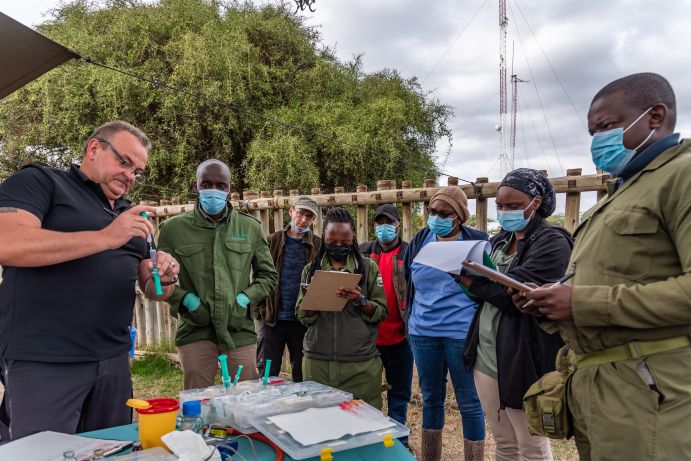A successful step in the fight to save the northern white rhinoceros: BioRescue team improves the genetic diversity of the future rhino population by creating another three embryos
The BioRescue project funded by the Federal Ministry of Education and Research (BMBF) successfully created another three embryos of the northern white rhinoceros, one of the rarest large mammals on earth and on the brink of extinction. In early July 2021, the BioRescue team conducted the sixth successful egg collection from northern white rhinos at Ol Pejeta Conservancy, Kenya. Immediately after the oocyte retrieval, the 17 eggs were airlifted to Avantea laboratory in Cremona, Italy, for maturation, fertilization, embryo development and cryopreservation.

Since the beginning of the project, the BioRescue team has collected a total of 80 eggs using its own patented procedure. The procedure involves inserting an ultrasound-guided probe into the rectum of the rhino. The team then uses a two-channelled needle to flush out the gut and the ovarian follicle and retrieve the eggs.
Two of the new embryos could be produced using semen from the already deceased northern white rhino bull Suni who had provided the genetics for all the embryos produced up to this point. Suni lived in the Safari Park Dvůr Králové (Czech Republic). In the case of the third embryo, the specialists at the Avantea laboratory succeeded for the first time in using semen from Angalifu, a northern white rhino bull who lived in the San Diego Zoo Safari Park for over 25 years and died in 2014. BioRescue project leader Professor Thomas Hildebrandt and his team had already collected his semen in 2001 and 2005. This was the first time that the genetics of an unrelated individual could be added to the cryo-preserved "embryo population", which significantly improves the genetic diversity of the future rhino population.
All 12 embryos created to the present were produced using oocytes from the rhino cow Fatu. Due to the advanced age of Fatu's mother Nájin and the reduced quality of her eggs, the BioRescue team decided not to perform further oocyte collections on Nájin.
The team at Ol Pejeta is currently preparing for the embryo transfer. Two female southern white rhinos, a similar subspecies of which a population of 18,000 still remains, were moved into the enclosure with Owuan, a sterilized southern white rhino bull. Owuan's libido will be indicative of the reproductive cycle of the surrogate mothers of the northern white rhino embryos. The Kenya Wildlife Service team is therefore carefully observing how Owuan and the females interact. These observations will serve to derive reproductive patterns which will allow the team to determine the optimal time for the embryo transfer. The first embryo transfers are likely to begin by the end of the year. This will be another promising milestone in the fight to save the northern white rhino.
Despite the COVID-19 pandemic, the BioRescue team aims to create more embryos from oocytes in a three to four-month cycle to make substantial progress as quickly as possible and thus to save the northern white rhino from extinction.
The BMBF is supporting the BioRescue project under its Research Initiative for the Conservation of Biodiversity (FEdA) and the Research for Sustainable Development (FONA) programme. The Leibniz Institute for Zoo and Wildlife Research and the Max Delbrück Center for Molecular Medicine are collaborating in this project with researchers and stakeholders from Italy, Kenya, Czech Republic, Japan and the USA.
Context
The northern white rhinoceros can weigh up to 2.4 tonnes. It is the third largest African animal and can live up to 40 years in the wild. There are currently five rhino species left on earth: the white, black, Sumatran, Indian and Javan. Black and white rhinos are found in Africa, while the others are found in Asia. The northern white rhino is generally considered a subspecies of white rhino (along with the southern white rhino).
Northern white rhinos are now widely believed to be extinct in the wild. The last four wild individuals were seen in Garamba National Park, Democratic Republic of Congo (DRC), in August 2005 and traces of their existence were still seen in 2007.
There are now just two rhinos left in captivity – Nájin and Fatu – who are heavily guarded in a semi-wild environment at Ol Pejeta Conservancy in Kenya. Poaching remains the main threat to their survival in the wild. In addition, the outbreak of conflicts and war is quashing the creation and development of protection and conservation initiatives.



